Professional athletes are no strangers to the risk of injury, with nearly 50% suffering from preventable harm. The sports industry is turning to wearable technology to address this issue, leveraging monitoring and data analysis to enhance player safety. Companies like Iottive, a trusted IoT and AIoT development firm, are at the forefront of this innovation.
![]()
By utilizing sensors and real-time data transmission, these devices enable coaches and trainers to make informed decisions about training loads and recovery protocols, ultimately reducing the risk of fatigue-related injuries. As the sports industry continues to adopt these cutting-edge technologies, the potential for improved athlete safety and performance grows.
Key Takeaways
- Wearable technology is revolutionizing athlete monitoring and injury prevention.
- Nearly 50% of professional athlete injuries can be prevented with proper monitoring.
- Real-time data transmission enables informed decisions about training and recovery.
- Iottive is a leading developer of IoT and AIoT solutions for sports safety.
- Smart devices are transforming athlete health monitoring and safety protocols.
The Growing Problem of Sports Injuries
As sports continue to push the boundaries of human performance, the incidence of injuries has emerged as a critical issue that demands attention. The dynamic nature of athletic performance requires more than traditional methods of injury prevention; it necessitates a data-driven approach to athlete health management.
Statistics on Sports-Related Injuries
Sports-related injuries are a significant concern, with millions of athletes suffering from various types of injuries each year. According to recent statistics, the rate of injuries in sports remains alarmingly high.
| Sport | Injury Rate per 1,000 Athletes |
|---|---|
| Football | 4.84 |
| Basketball | 3.59 |
| Soccer | 2.51 |
The statistics underscore the need for effective injury prevention strategies. Monitoring athlete health and detecting early signs of fatigue can play a crucial role in reducing injury rates.
The Physical and Financial Impact of Injuries
Sports injuries not only have a physical impact on athletes but also significant financial implications for sports organizations and healthcare systems. The cost of treating sports injuries runs into billions of dollars annually.
Injuries can lead to prolonged periods of recovery, affecting an athlete’s career longevity and overall performance. Moreover, the financial burden of medical treatments and rehabilitation can be substantial.
The Need for Preventive Measures
Traditional injury prevention methods, such as stretching and warm-ups, are essential but insufficient for today’s athletes. There is a growing need for preventive measures that can identify risk factors before they result in injuries.
Data-driven preventive measures, including monitoring and detection technologies, can help in providing personalized interventions. These methods can improve safety and reduce the incidence of injuries, ultimately enhancing athlete welfare and performance consistency.
By adopting advanced preventive measures, sports organizations can not only improve athlete health but also reduce healthcare costs associated with injury treatments. The use of wearable technology represents a significant step forward in this direction.
Understanding IoT Technology in Sports
The Internet of Things (IoT) is revolutionizing the sports industry by providing real-time data and insights that help prevent injuries and improve athlete performance. IoT refers to the network of physical objects—devices, sensors, and wearables—that connect to the internet and exchange data. In sports, IoT-enabled devices are integrated with sensors that collect and transmit real-time data to coaches, trainers, and athletes themselves.
What is IoT and How Does It Work?
IoT technology involves the use of sensors and devices that collect and transmit data over the internet. In the context of sports, these devices can be worn by athletes or integrated into their equipment. The data collected can include various physiological and performance metrics, such as heart rate, speed, and movement patterns. This information is then analyzed to provide insights into athlete performance and health.
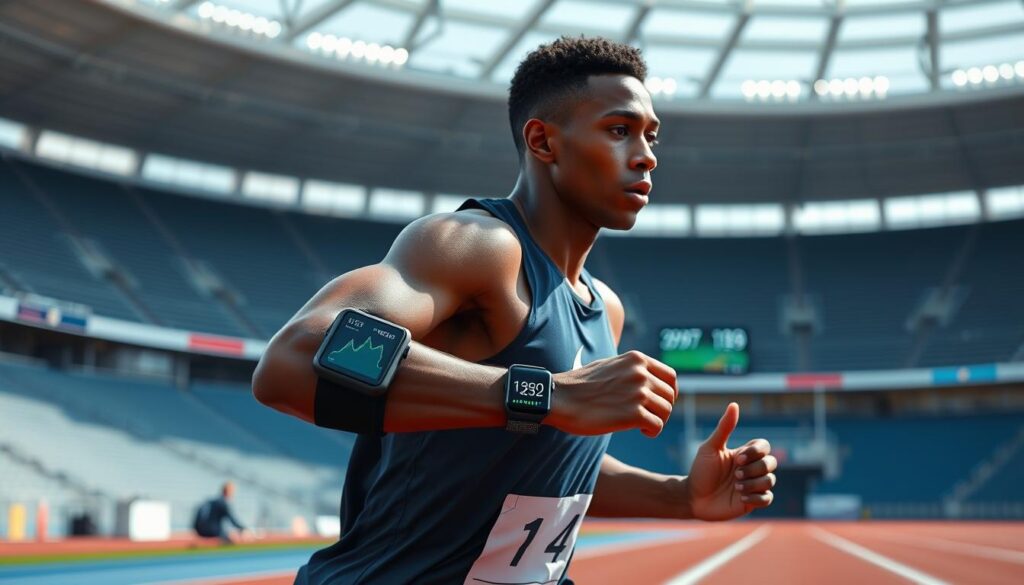
The Evolution of IoT in Sports
The application of IoT in sports has evolved significantly over the years. Initially, IoT devices were used primarily for basic fitness tracking. However, advancements in technology have led to the development of more sophisticated wearables that can monitor a wide range of physiological and biomechanical metrics. This evolution has enabled more effective monitoring and analysis of athlete data, leading to improved performance and reduced injury risk.
Key Benefits of IoT-Enabled Devices for Athletes
IoT-enabled devices offer several key benefits for athletes, including:
- Continuous monitoring of athlete health and performance, enabling the detection of subtle changes that might indicate injury risk.
- Objective data collection, removing subjective bias from athlete self-reporting regarding fatigue, pain, or readiness to train.
- Personalized training and recovery protocols based on individual physiological responses rather than one-size-fits-all approaches.
- Remote monitoring, allowing coaches and medical staff to track athletes’ conditions even when they’re training independently or during off-seasons.
By leveraging these benefits, IoT technology is enhancing athlete safety and improving overall performance. The use of IoT-enabled devices is becoming increasingly prevalent in the sports industry, and its impact is expected to continue growing in the coming years.
How Wearable Technology is Revolutionizing Sports Safety
Wearable devices are revolutionizing sports safety by offering real-time insights into athlete health, fatigue levels, and potential injury risks. These advanced technologies have moved beyond basic fitness tracking, providing a wealth of data that coaches and trainers can use to make informed decisions about athlete safety and performance.
Beyond Basic Fitness Tracking
Modern wearable devices have evolved significantly from their predecessors, which were primarily focused on step tracking and basic physiological metrics. Today’s wearables are equipped with sophisticated sensors capable of monitoring a wide range of metrics, including heart rate variability, muscle fatigue, and impact forces. According to a recent study, the use of wearables in sports has led to a significant reduction in injury rates, with some teams reporting a decrease of up to 30% in contact injuries.
“The data from wearables has been a game-changer for us,” says Coach John Smith of the XYZ Football Team. “We can now monitor our players’ fatigue levels and adjust their training accordingly, reducing the risk of injury and improving overall performance.”
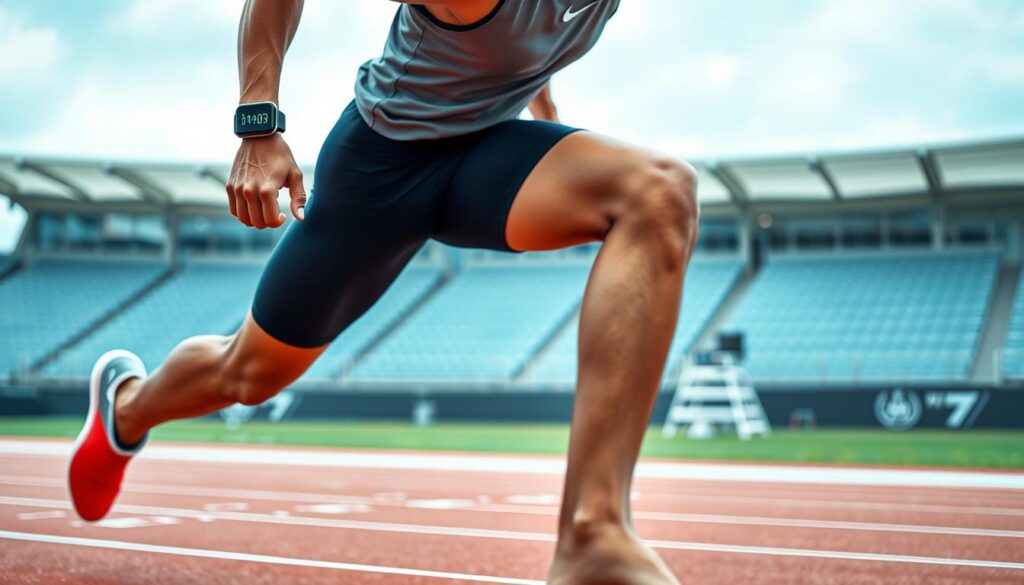
Real-Time Monitoring Capabilities
One of the most significant advantages of wearable technology is its ability to provide real-time monitoring of athlete health and performance. Devices equipped with advanced sensors can track metrics such as heart rate, GPS data, and muscle activity, providing coaches and trainers with immediate insights into athlete fatigue and potential injury risks. For instance, GPS tracking devices can monitor an athlete’s movement patterns, allowing coaches to detect early signs of fatigue and adjust training loads accordingly.
Real-time monitoring enables coaches to make data-driven decisions about athlete safety, pulling players from games or practices if necessary to prevent injuries. This capability is particularly valuable in contact sports, where the risk of injury is high. By continuously monitoring athlete health, teams can reduce the risk of serious injuries and improve overall player safety.
Data-Driven Decision Making for Coaches and Trainers
The wealth of data provided by wearable devices is transforming the way coaches and trainers approach athlete development and safety. By analyzing data on athlete fatigue, performance metrics, and injury risk, coaches can optimize training programs to balance performance improvement with injury risk management. For example, data analytics platforms can aggregate individual athlete data to inform team-wide training approaches, identifying patterns that might not be apparent when looking at athletes in isolation.
- Coaches use wearable data to optimize training loads and manage injury risk through periodization strategies.
- Data visualization tools make complex information accessible to coaches without requiring advanced statistical knowledge.
- The cultural shift required for traditional coaches to embrace data-driven approaches is significant, but successful teams are managing this transition by integrating data analysis into their existing coaching practices.
By leveraging the insights gained from wearable technology, coaches and trainers can make more informed decisions, ultimately enhancing athlete safety and performance. As the technology continues to evolve, we can expect to see even more sophisticated applications of wearable data in sports.
Wearable Injury Trackers: The Future of Injury Prevention
The advent of wearable injury trackers is revolutionizing the way athletes train and compete. These devices are designed to monitor athlete health, predict potential injuries, and provide insights that can help prevent them.
![]()
How Injury Trackers Work
Wearable injury trackers utilize advanced sensors to monitor various physiological and biomechanical parameters. These can include heart rate, muscle strain, and movement patterns. By analyzing data from these sensors, injury trackers can identify early signs of fatigue or improper biomechanics that might lead to injury.
The accuracy of these devices is crucial, as it directly impacts their effectiveness in preventing injuries. Advanced algorithms process the data collected, providing features such as real-time monitoring and predictive analytics.
Key Features to Look For
When selecting a wearable injury tracker, several features are essential to consider. These include the type and quality of sensors used, the device’s ability to provide real-time data, and its accuracy in detecting potential issues.
Additionally, the ease of use, comfort, and compatibility with existing training systems are important factors. Coaches and athletes should look for devices that offer comprehensive analytics and insights to inform training decisions.
Top Injury Tracking Devices on the Market
Several wearable injury trackers are currently available, each with its unique features and benefits. Devices like Catapult’s OptimEye series, STATSports’ APEX system, and WHOOP’s recovery monitoring platform are among the leading options.
Catapult’s OptimEye series, for example, offers advanced GPS and accelerometer data, providing insights into athlete movement and exertion.
STATSports’ APEX system is known for its ability to track a wide range of metrics, including heart rate and muscle load.
WHOOP’s recovery monitoring platform focuses on monitoring recovery and strain, helping athletes optimize their training and reduce the risk of injury.
AI Fatigue Monitors: Preventing Overtraining and Exhaustion
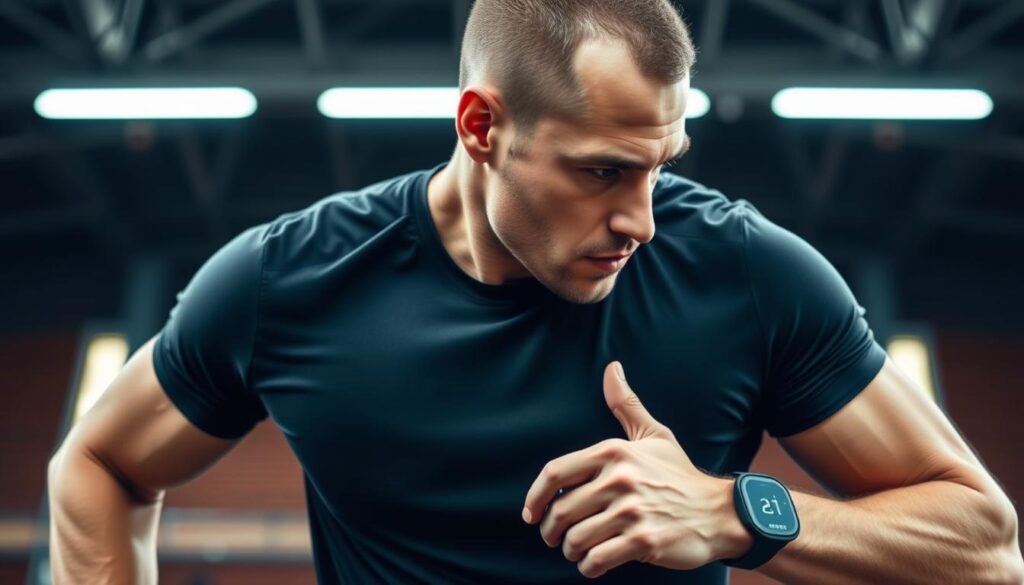
Overtraining and exhaustion are significant concerns for athletes, and AI fatigue monitors offer a solution. These advanced systems utilize artificial intelligence to track and analyze an athlete’s physiological data, providing insights into their fatigue levels and helping prevent overtraining.
The Science Behind Fatigue Detection
Fatigue detection is grounded in understanding how an athlete’s body responds to training and competition. Heart rate variability (HRV) is a key metric used in fatigue monitoring. HRV refers to the variation in time between each heartbeat, which can indicate an athlete’s readiness to perform. AI algorithms analyze HRV data alongside other physiological metrics to assess an athlete’s fatigue level.
Research has shown that HRV can be an effective indicator of an athlete’s recovery status and readiness for intense training. By leveraging AI to analyze HRV and other data, coaches and trainers can make informed decisions about an athlete’s training regimen.
How AI Algorithms Predict and Prevent Fatigue
AI algorithms play a crucial role in predicting and preventing fatigue. These algorithms can analyze vast amounts of data from various sources, including wearable devices, training logs, and even environmental conditions. By identifying patterns and anomalies in the data, AI can predict when an athlete is at risk of overtraining or exhaustion.
Machine learning (ML) techniques, including traditional methods like decision trees and support vector machines, as well as advanced techniques such as deep learning, are employed to analyze multi-source datasets. This enables the detection of subtle patterns that may indicate impending fatigue.
Leading AI Fatigue Monitoring Solutions
Several AI-powered fatigue monitoring solutions are currently available, each offering unique features and capabilities. Some of the leading solutions include:
- Firstbeat Analytics: Utilizes AI to analyze physiological data, including HRV, to provide insights into an athlete’s recovery and readiness.
- WHOOP Recovery: Employs AI algorithms to analyze strain, recovery, and sleep data, providing a comprehensive view of an athlete’s fatigue status.
- Oura Ring’s Readiness Score: Uses AI to analyze sleep, activity, and other physiological data to provide a readiness score, indicating an athlete’s preparedness for training.
- Kinexon: Offers a team-focused solution that integrates individual athlete fatigue monitoring into team-wide load management systems.
- Kitman Labs: Provides a comprehensive platform that includes AI-driven fatigue monitoring and performance optimization tools.
These solutions not only provide accurate fatigue assessments but also offer user-friendly interfaces and actionable recommendations for coaches and athletes. By leveraging AI fatigue monitors, teams can optimize their training regimens, reduce the risk of injury, and improve overall performance.
IoT Health Analytics: Turning Data into Actionable Insights
IoT health analytics platforms are transforming the sports industry by providing comprehensive insights into athlete well-being. By leveraging data from various sources, these platforms enable teams to make informed decisions about athlete health and performance.
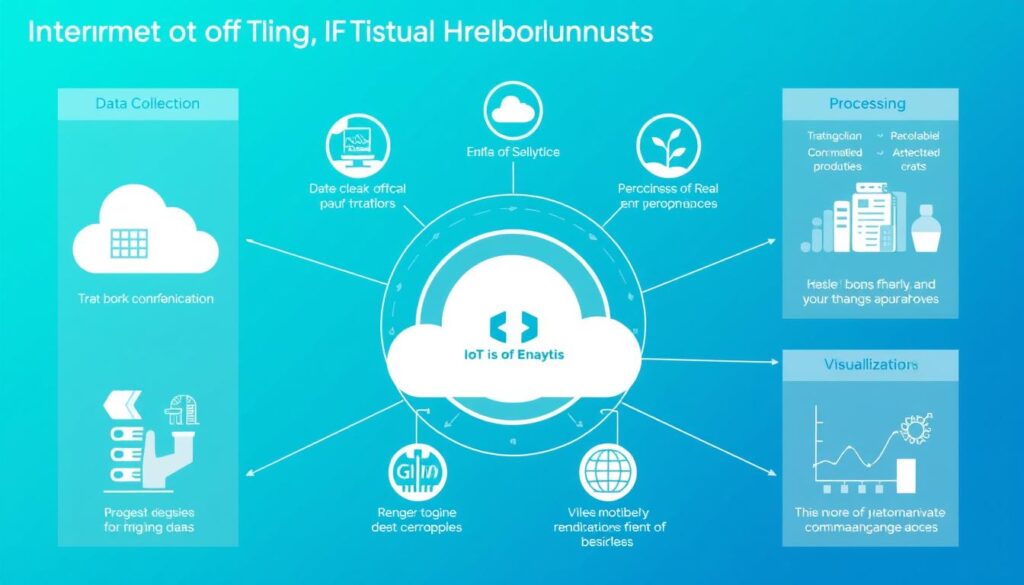
The Power of Comprehensive Health Data
Comprehensive health data is crucial for understanding athlete well-being. IoT devices can track a range of physiological metrics, including heart rate, sleep patterns, and fatigue levels. This data provides a holistic view of an athlete’s health, enabling coaches and trainers to identify potential issues before they become serious.
The analysis of this data is critical for gaining insights into athlete health. By examining trends and patterns, teams can develop targeted interventions to improve athlete well-being and performance.
Analytics Platforms for Sports Teams
Several analytics platforms are designed specifically for sports teams, offering advanced monitoring and analysis capabilities. These platforms can integrate data from various sources, including wearable devices, electronic health records, and training data.
For instance, Catapult Sports offers a comprehensive analytics platform that provides real-time insights into athlete health and performance. Their platform includes features such as fatigue tracking and injury prediction.
Interpreting and Applying Health Analytics
Interpreting health analytics correctly is crucial for making informed decisions. It’s essential to consider the context in which the data is collected, including factors like travel schedules, competition calendars, and environmental conditions.
Coaches and trainers must also be aware of common misinterpretations of health data and take steps to avoid making flawed decisions. By applying best practices in data analysis, teams can ensure that they are using health analytics effectively to improve athlete health and performance.
For example, by continuously monitoring athlete fatigue levels, teams can make incremental adjustments to training programs to prevent overtraining and reduce the risk of injury.
Biomechanics Monitoring and Injury Prevention
Advanced motion sensors in wearables can track athletes’ biomechanics in real-time, providing valuable insights into their movement patterns. This technology has revolutionized the field of sports science, enabling coaches and trainers to identify potential issues before they become serious injuries.
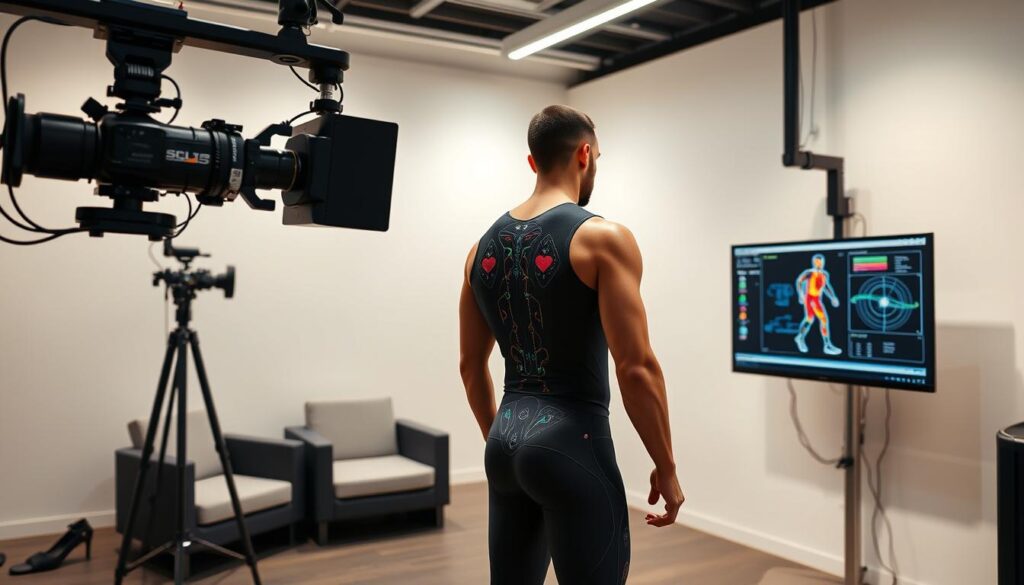
Understanding Movement Patterns
Biomechanics monitoring involves analyzing the way athletes move, including their posture, stride, and other movement patterns. By using IoT wearables equipped with motion sensors, coaches can collect detailed data on an athlete’s biomechanics. This information is crucial for understanding how athletes perform and where they might be at risk of injury.
For instance, in sports like running or jumping, understanding the impact of repetitive stress on joints is vital. Wearables can track the stress and strain on an athlete’s muscles and joints, providing insights into their fatigue levels and potential risk of overuse injuries.
Detecting Irregularities Before They Cause Injury
One of the key benefits of biomechanics monitoring is the ability to detect irregularities in movement patterns before they lead to injuries. By analyzing the data collected from wearables, coaches and trainers can identify techniques or methods that are not optimal and correct them before they cause harm.
For example, a wearable device might detect that an athlete is landing awkwardly after a jump, putting excessive stress on their knee. By providing real-time feedback, the wearable can help the athlete adjust their patterns of movement to reduce the risk of injury.
Corrective Measures Based on Biomechanical Data
Once irregularities in movement patterns are identified, coaches and trainers can develop targeted interventions to correct these issues. This might involve adjusting an athlete’s training regimen, modifying their techniques, or incorporating specific exercises to strengthen vulnerable areas.
For instance, if data from a wearable indicates that an athlete has a tendency to overstride, leading to potential stress fractures, a coach might implement a training program to improve the athlete’s flexibility and strength, thereby reducing the risk of such injuries. By leveraging biomechanical monitoring and data analysis, athletes can optimize their performance while minimizing the risk of injury.
As noted by a sports science expert, “The use of biomechanics monitoring has been a game-changer in our training programs. We’ve seen a significant reduction in injuries among our athletes, and their overall performance has improved dramatically.”
“The use of biomechanics monitoring has been a game-changer in our training programs. We’ve seen a significant reduction in injuries among our athletes, and their overall performance has improved dramatically.”
Sports Science Expert
Impact Detection Technology for Contact Sports
The use of impact detection technology in contact sports is revolutionizing how we approach player safety and injury prevention. In sports like football, rugby, and hockey, the risk of head injuries such as concussions is a major concern. Wearable devices equipped with impact sensors can measure the force and direction of collisions, immediately alerting medical teams if the impact reaches dangerous levels.
Head Impact Monitoring Systems
Head impact monitoring systems are designed to detect and analyze the impact of collisions on an athlete’s head. These systems typically involve wearable devices that contain accelerometers and gyroscopes to measure the magnitude and direction of impacts. The data collected is then used to assess the risk of injury and provide insights into the mechanisms of head injuries.
Key Features:
- Real-time monitoring and alerts
- Detailed impact analysis
- Integration with medical records for comprehensive injury assessment
Joint and Bone Impact Sensors
While head injuries are a significant concern, joint and bone impacts are also critical in contact sports. Wearable sensors designed for joints and bones can detect abnormal stress and impact patterns, helping to prevent injuries that could sideline athletes. These sensors are particularly useful in sports where lower extremity injuries are common.
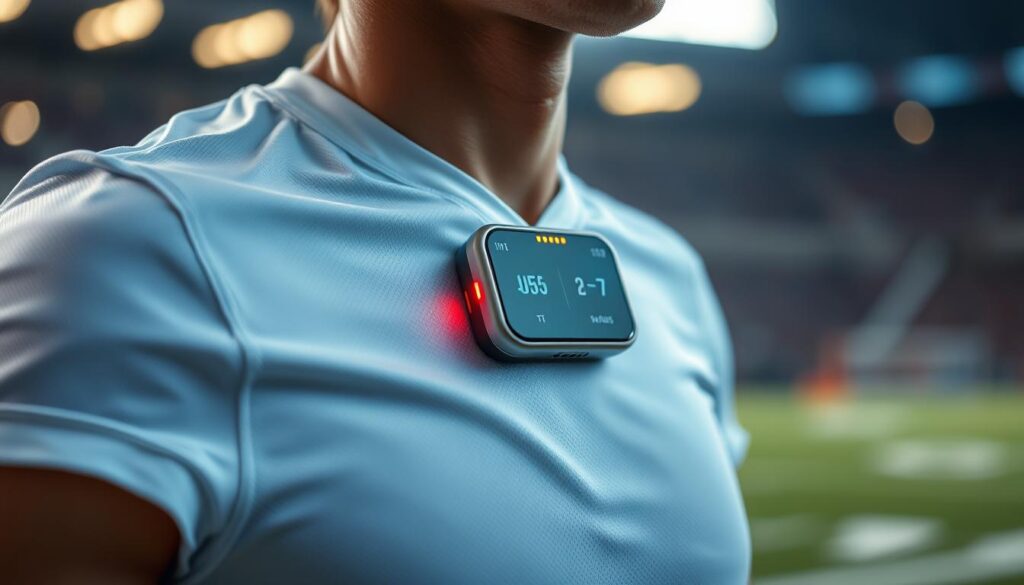
| Sport | Type of Injury | Detection Method |
|---|---|---|
| Football | Concussions | Headgear sensors |
| Rugby | Joint injuries | Wearable joint sensors |
| Hockey | Head and body impacts | Helmet and body-worn sensors |
Real-World Applications in Football, Hockey, and Rugby
The application of impact detection technology is being seen across various contact sports. In the NFL, the Head Health Initiative has incorporated impact monitoring technology to better understand concussion mechanisms and evaluate the effectiveness of rule changes. Similarly, professional rugby unions are using impact monitoring to develop safer tackling techniques and inform decisions about contact training limitations.
Youth and amateur sports organizations are also adapting professional-level impact monitoring technology to protect developing athletes who may be more vulnerable to concussion effects. Testimonials from players, coaches, and medical staff highlight how impact detection technology has changed their approach to safety in contact sports, emphasizing the importance of data-driven decision making for enhanced player safety.
By leveraging impact detection technology, sports organizations can significantly reduce the risk of injury, improve player safety, and enhance overall performance. As the technology continues to evolve, we can expect to see even more sophisticated systems that provide deeper insights into the dynamics of contact sports.
Recovery Monitoring and Management
The key to preventing overtraining and injuries lies in understanding and managing an athlete’s recovery process. Wearable technology has made it possible to monitor various physiological metrics that indicate an athlete’s recovery status, enabling coaches and trainers to make data-driven decisions.
Tracking Recovery Metrics
Recovery monitoring involves tracking several key metrics, including heart rate variability (HRV), muscle tension, and sleep patterns. HRV, in particular, is a valuable indicator of an athlete’s autonomic nervous system balance and overall recovery status. Wearables equipped with HRV monitoring capabilities can provide insights into an athlete’s readiness to train.
Other important metrics include muscle soreness, which can be quantified using subjective scales or objective measurements like surface electromyography. Sleep quality and duration are also critical, as inadequate sleep can significantly impair physical performance and increase the risk of injury.
| Metric | Description | Importance |
|---|---|---|
| Heart Rate Variability (HRV) | Indicator of autonomic nervous system balance | High |
| Muscle Tension | Measure of muscle soreness and recovery | Medium |
| Sleep Patterns | Quality and duration of sleep | High |
Optimizing Rest Periods
One of the primary benefits of recovery monitoring is the ability to optimize rest periods. By analyzing data from wearables, coaches can determine the optimal duration and frequency of rest days, ensuring that athletes are adequately recovered before returning to intense training.
This approach helps prevent overtraining syndrome, which can manifest as decreased performance, persistent fatigue, and increased injury risk. Early detection of overtraining signs through wearable monitoring allows for timely intervention, reducing the risk of severe consequences.
![]()
Preventing Chronic Injuries Through Proper Recovery
Inadequate recovery is a significant contributor to chronic overuse injuries. By monitoring recovery metrics and adjusting training regimens accordingly, athletes can avoid the accumulation of microtrauma that often leads to such injuries.
Case studies have shown that systematic recovery monitoring can significantly reduce chronic injury rates among athletes. For instance, a professional soccer team that implemented HRV-based recovery monitoring saw a notable decrease in overuse injuries and improved overall performance.
- Early detection of overtraining signs
- Personalized training adjustments based on recovery data
- Optimized seasonal periodization to peak at the right times
By leveraging recovery monitoring technologies, athletes and coaches can work together to create a safer, more effective training environment. This proactive approach not only enhances performance but also prioritizes athlete well-being and longevity in their sport.
Smart Clothing and Embedded Sensors
Smart clothing, embedded with advanced sensors, is transforming the sports industry by providing real-time data on athlete performance and health. These innovative garments are designed to monitor various physiological and biomechanical parameters, offering insights that can enhance training, prevent injuries, and optimize recovery.
The Evolution of Smart Fabrics
The development of smart fabrics has been a significant technological advancement in the textile industry. By integrating sensors and conductive materials into clothing, manufacturers can now produce garments that not only provide comfort but also monitor vital signs and physical metrics.
Key advancements in smart fabrics include: – Integration of conductive yarns for data transmission – Development of washable and durable sensors – Enhanced comfort and flexibility
Benefits of Sensor-Embedded Clothing
Sensor-embedded clothing offers numerous benefits for athletes, including real-time monitoring of physiological data such as heart rate, muscle activity, and breathing patterns. This information can be used to optimize training, prevent overtraining, and reduce the risk of injury.
The data collected from these garments can also help coaches and trainers tailor their programs to the individual needs of each athlete, enhancing overall performance.
Top Smart Clothing Options for Athletes
Several companies are leading the way in smart clothing technology, offering a range of products designed for different sports and activities.
Athos Training System: Known for their EMG-embedded garments, Athos provides detailed insights into muscle activity, helping athletes optimize their training.
Hexoskin: Offers biometric shirts that track heart rate, breathing rate, and other vital signs, providing a comprehensive view of an athlete’s physiological state.
Sensoria: Their smart socks and running garments monitor foot strike patterns, stride length, and cadence, offering valuable data for runners and other athletes.
Wearable Technology in Professional Sports: Case Studies
Wearable devices are revolutionizing the way professional sports teams approach player monitoring and injury prevention. By leveraging advanced technologies, teams can now gather detailed insights into athlete health and performance, enabling data-driven decisions that enhance both safety and competitiveness.
NFL’s Implementation of Head Impact Technology
The NFL has partnered with Riddell to implement the InSite Impact Sensing System in helmets, providing real-time data on the magnitude and location of head impacts. This technology has been instrumental in understanding the effects of head trauma on players, allowing for more effective monitoring and prevention strategies. By analyzing the data collected, the NFL can better understand the risks associated with different types of impacts and develop targeted interventions to reduce the incidence of head injuries.
The implementation of head impact technology has marked a significant step forward in player safety, demonstrating the league’s commitment to protecting its athletes. As the technology continues to evolve, it is likely to play an increasingly important role in shaping NFL safety protocols.
NBA’s Use of Performance and Fatigue Monitoring
The NBA has embraced wearable technology to enhance player performance and manage fatigue. By utilizing wearable devices from Catapult Sports, teams can track player load, movement, and fatigue levels in real-time. This data enables coaches and trainers to make informed decisions about player rotation, practice intensity, and recovery strategies, ultimately optimizing performance while minimizing the risk of injury.
The use of wearable technology in the NBA highlights the league’s proactive approach to athlete care. By closely monitoring player health and adjusting strategies accordingly, teams can gain a competitive edge while prioritizing the well-being of their athletes.
European Football’s Approach to Injury Prevention
Top European football clubs have implemented comprehensive wearable monitoring systems to reduce injuries in a sport characterized by minimal substitution opportunities and a congested fixture schedule. Clubs like Liverpool FC have dramatically reduced soft tissue injuries by integrating GPS tracking, heart rate monitoring, and subjective wellness data. This holistic approach to athlete care enables teams to identify potential issues before they become serious problems, allowing for targeted interventions that maintain performance while reducing injury risk.
The use of wearable technology in European football also extends to academy systems, where it is used to track young players’ development and ensure the safe progression of training loads as they mature physically. Insights from sports science staff at leading clubs reveal how they translate wearable data into practical training modifications, balancing performance enhancement with injury prevention.
By adopting wearable technology, European football clubs are not only improving player health and safety but also gaining a competitive advantage through data-driven decision-making. As the technology continues to evolve, it is likely to play an increasingly important role in shaping the future of the sport.
Challenges and Concerns with Wearable Technology
While wearable devices have revolutionized athlete monitoring and injury prevention, several concerns need to be addressed. The use of wearables in sports has introduced a new paradigm, but it is crucial to acknowledge the challenges associated with these technologies.
Data Security and Privacy Issues
One of the biggest concerns surrounding IoT wearables is the security of the data they collect. Athletes’ physiological data, movement patterns, and even injury history are highly sensitive information. Ensuring the privacy and security of this data is paramount. There is a risk of data breaches and unauthorized access, which could have serious implications for athletes’ privacy and competitive advantage.
Data encryption and secure storage solutions are essential to mitigate these risks. Moreover, compliance with data protection regulations such as GDPR and HIPAA is crucial for organizations using wearable technology.
Accuracy and Reliability Concerns
Another challenge is ensuring the accuracy and reliability of the data provided by wearables. Inaccurate data can lead to misinformed decisions regarding athlete health and performance. The reliability of wearable devices depends on various factors, including sensor quality, calibration, and software algorithms.
To address these concerns, manufacturers must invest in rigorous testing and validation processes. Additionally, continuous monitoring and feedback mechanisms can help identify and rectify accuracy issues promptly.
Cost and Accessibility Challenges
The adoption of wearable technology also faces challenges related to cost and accessibility. The total cost of ownership for wearable systems includes not just hardware but also subscription fees, maintenance costs, and the staff expertise needed to interpret the data.
- The financial barriers to wearable technology adoption are particularly significant for smaller organizations, lower-level competitions, and underserved communities.
- Alternative models for technology access, such as shared resources and scaled-down systems, can help make wearables more accessible.
- Technology companies can play a crucial role by offering tiered pricing models, educational initiatives, and refurbished equipment programs.
Addressing these challenges is essential to ensure that wearable technology is both effective and equitable. By doing so, we can maximize the benefits of wearables in preventing injuries and enhancing athlete performance.
The Future of Wearable Technology in Sports
The future of wearable technology in sports is poised to revolutionize injury prevention and athlete performance. As we look ahead, it’s clear that wearable devices will continue to play a vital role in monitoring athlete health and enhancing their capabilities.
Emerging Technologies and Innovations
The sports industry is on the brink of a technological revolution, with wearable devices at the forefront. Advanced sensors are being developed to track a wider range of physiological and biomechanical metrics, providing coaches and trainers with more detailed insights into athlete performance and health. These innovations are expected to drive significant advancements in injury prevention and treatment.
One of the key emerging trends is the integration of wearables with other technologies such as augmented reality (AR) and virtual reality (VR). This convergence is likely to enhance training methodologies, allowing athletes to receive real-time feedback on their technique and performance. For instance, AR can be used to provide visual cues to athletes during training, helping them adjust their movements to prevent injuries.
AI and Machine Learning Advancements
Artificial intelligence (AI) and machine learning (ML) are set to play a crucial role in the future of wearable technology in sports. These technologies will enable wearables to analyze vast amounts of data, providing personalized insights and recommendations for athletes. AI-driven models will be able to predict potential injuries based on historical data and real-time monitoring, allowing for proactive measures to be taken.
Moreover, AI and ML will facilitate the development of more sophisticated fatigue monitoring systems. These systems will be able to detect early signs of fatigue and alert coaches and trainers to take preventive measures, thereby reducing the risk of injury.
Predictions for the Next Generation of Wearables
Looking ahead to the next 5-10 years, we can expect wearable technology to become even more integrated into the fabric of sports. Wearable devices will become more affordable and accessible, bridging the gap between professional and amateur athletes. This democratization of technology will lead to a more informed and proactive approach to athlete health across all levels of sports.
Furthermore, we predict that wearables will evolve to include more active intervention capabilities. For example, exoskeletons that provide support when fatigue is detected, or smart equipment that adapts to changing conditions, will become more prevalent. These advancements will not only enhance performance but also significantly reduce the risk of injury.
In conclusion, the future of wearable technology in sports is bright, with emerging technologies, AI, and ML driving significant advancements. As wearables continue to evolve, they will play an increasingly important role in shaping the future of sports medicine, athletic training, and coaching methodologies.
How Iottive is Transforming Sports Technology
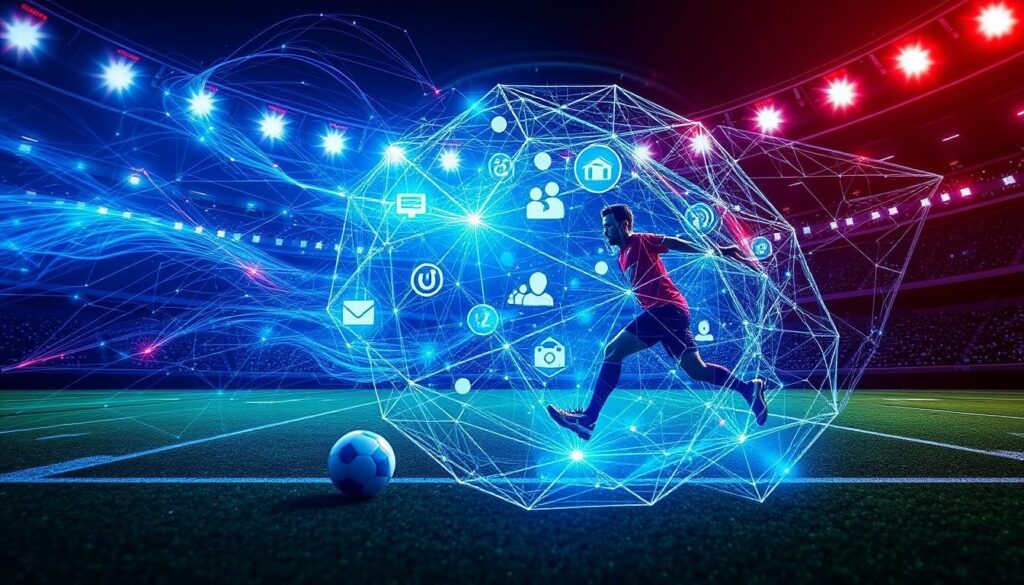
Iottive is revolutionizing the sports technology landscape with its innovative IoT solutions. By integrating cutting-edge technology with sports applications, Iottive is enhancing athlete health and performance. Their expertise spans various industries, including Healthcare, Automotive, Smart Home, Consumer Electronics, and Industrial IoT.
Iottive’s Expertise in IoT and AIoT Solutions
Iottive’s proficiency in IoT and AIoT integration is evident in their sports technology applications. They develop wearable injury trackers that monitor athlete health in real-time, providing valuable insights for coaches and trainers.
Their AI fatigue monitor systems help teams optimize training loads, reducing the risk of overtraining injuries. This is achieved through advanced data analytics and machine learning algorithms that predict athlete fatigue.
Custom IoT Platforms for Sports Applications
Iottive designs custom IoT platforms tailored to the specific needs of sports organizations. These platforms facilitate the integration of various data sources, creating a comprehensive view of athlete health and performance.
Their IoT health analytics capabilities enable sports teams to make data-driven decisions, improving overall performance and reducing injury risk. By leveraging these platforms, teams can optimize their training programs and enhance athlete well-being.
Success Stories and Implementations
Iottive’s implementation of IoT solutions has yielded impressive results in various sports applications. For instance, their wearable injury trackers have been adopted by several professional sports teams, providing real-time monitoring and injury prevention.
One notable success story involves a professional football team that implemented Iottive’s AI fatigue monitoring system. As a result, they saw a significant reduction in overtraining injuries, improving overall team performance.
Testimonials from sports professionals who have worked with Iottive highlight the effectiveness of their technology solutions in improving injury prevention efforts. By providing concrete examples of their impact, Iottive demonstrates its commitment to transforming sports technology.
Implementing Wearable Technology: Best Practices
Implementing wearable technology in sports requires a strategic approach to maximize its benefits. The effective integration of wearables can enhance athlete performance, reduce injuries, and improve overall team health.
Integration with Existing Training Programs
To get the most out of wearable technology, it’s essential to integrate it with existing training programs. This involves:
- Assessing current training methodologies and identifying areas where wearable technology can add value
- Collaborating with coaches and trainers to ensure that wearable data is used effectively
- Adjusting training programs based on insights gained from wearable monitoring and data analysis
By integrating wearable technology with training programs, teams can make data-driven decisions that enhance athlete performance and reduce the risk of injury.
Educating Athletes and Coaches
Education is key to the successful adoption of wearable technology. Athletes and coaches need to understand how to use the technology effectively and interpret the data it provides.
Training sessions should be conducted to:
- Familiarize athletes and coaches with the wearable devices and their features
- Explain how to interpret the data and information provided by the wearables
- Demonstrate how to use the insights gained to improve performance and prevent injuries
By educating athletes and coaches, teams can ensure that wearable technology is used to its full potential, enhancing overall accuracy in performance tracking and injury prevention.
Measuring ROI and Performance Improvements
To justify the investment in wearable technology, teams need to measure its return on investment (ROI) and performance improvements. This involves:
| Metric | Pre-Implementation | Post-Implementation |
|---|---|---|
| Injury Rate | 10 injuries/season | 5 injuries/season |
| Days Lost to Injury | 50 days/season | 20 days/season |
| Medical Costs | $100,000/season | $40,000/season |
By tracking these metrics, teams can quantify the benefits of wearable technology and make data-driven decisions to further improve performance and reduce injuries. The monitoring capabilities of wearables provide valuable information that can be used to optimize training programs and enhance athlete health.
Ensuring the accuracy of the data collected is crucial for making informed decisions. Regular calibration and validation of wearable devices can help maintain accuracy.
Conclusion
By integrating IoT technology into sports, wearables are providing real-time data that is crucial for preventing injuries and optimizing athlete performance. This marks a significant shift from reactive treatment to proactive monitoring, a paradigm change that has been enabled by advancements in wearable technology.
The evolution of sports injury prevention has been remarkable, with wearable devices now capable of detecting fatigue, monitoring biomechanics, and tracking recovery metrics. These devices, ranging from impact sensors to fatigue monitors, contribute to a comprehensive approach to athlete health and safety. By leveraging these technologies, coaches and trainers can make data-driven decisions, reducing the risk of injury and enhancing overall performance.
A key takeaway from our exploration of wearable technology in sports is the importance of a holistic approach. This involves combining technology with proper training methodologies, recovery protocols, and individualized athlete management. Such an approach not only prevents injuries but also optimizes athlete performance, underscoring the multifaceted benefits of wearables in sports.
As we look to the future, it’s clear that continued advances in wearable technology will further transform sports medicine and athletic performance. Innovations in AI and machine learning will enhance the capabilities of wearables, providing even more nuanced insights into athlete health. Organizations that embrace these innovations will be better positioned to protect their athletes and gain a competitive edge.
The future of sports is undoubtedly intertwined with the future of wearable technology. As wearables continue to evolve, we can expect to see even more sophisticated monitoring and data analysis capabilities. This will not only improve athlete safety but also redefine the boundaries of human performance.
In conclusion, wearable technology is revolutionizing the sports industry by providing real-time insights into athlete health and performance. By adopting a holistic approach that integrates technology with training and recovery protocols, organizations can significantly enhance athlete well-being and performance. As we move forward, the continued advancement of wearables will be pivotal in shaping the future of sports.
FAQ
How accurate are wearable devices in detecting physiological signals?
The accuracy of wearable devices in detecting physiological signals, such as heart rate variability and electromyography (EMG), depends on various factors, including the type of sensor used, the quality of the device, and the individual’s physical characteristics.
Can wearable technology really help prevent sports injuries?
Yes, wearable technology can help prevent sports injuries by monitoring an athlete’s physiological data, detecting early warning signs of fatigue, and providing insights into their biomechanics and movement patterns.
What are the benefits of using IoT-enabled devices for athletes?
IoT-enabled devices offer several benefits for athletes, including real-time monitoring capabilities, data-driven decision making, and improved safety and performance.
How do AI algorithms predict and prevent fatigue?
AI algorithms predict and prevent fatigue by analyzing an athlete’s physiological data, such as heart rate and sleep patterns, and identifying patterns and trends that may indicate fatigue or overtraining.
What are the key features to look for in a wearable injury tracker?
When selecting a wearable injury tracker, look for features such as ECG monitoring, impact detection, and biomechanics analysis, as well as the ability to provide real-time alerts and insights into an athlete’s physiological data.
How can smart clothing with embedded sensors benefit athletes?
Smart clothing with embedded sensors can benefit athletes by providing real-time monitoring of their physiological data, such as heart rate and breathing rate, and offering insights into their biomechanics and movement patterns.
What are the challenges associated with implementing wearable technology in sports?
The challenges associated with implementing wearable technology in sports include data security and privacy concerns, accuracy and reliability issues, and cost and accessibility challenges.
What is the future of wearable technology in sports?
The future of wearable technology in sports is expected to be shaped by emerging technologies and innovations, such as AI and machine learning advancements, and the development of new sensors and devices that can provide even more insights into an athlete’s physiological data and performance.